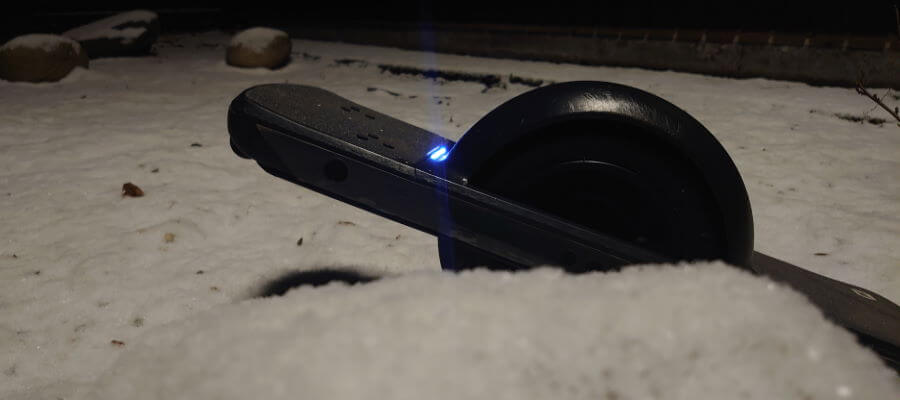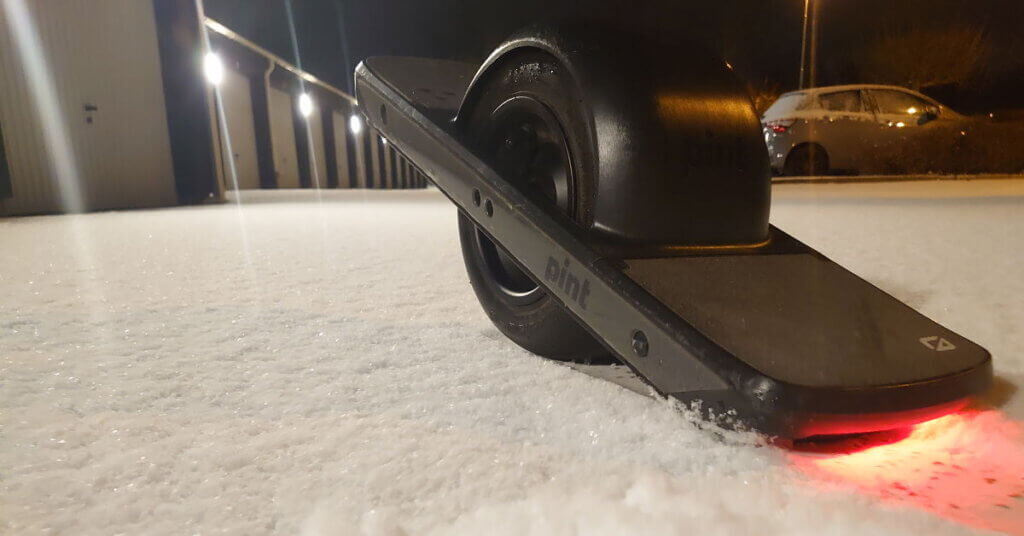The stock Onewheel tire either if it’s XR or Pint does quite well on snow, as long as it’s not an icy road or frozen lake. I recommend you not to start changing the tire just for winter riding if you don’t plan to ride every day or are into trail riding.
The most important upgrade is to apply a waterproofing kit from Badger Wheel that will make your board a bit more waterproof, and reduce the risk of water entering the common places/areas where water can get into the electronics.
The Onewheel isn’t waterproof and some are built like tanks and some only survive a single puddle. What’s even worse when riding in the winter is the salt on the road. Make sure to wipe down your board after a ride.
Be prepared for a drastic range decrease of 20-40% depending on the board. Also, never leave your board in the cold below freezing, and always store and charge it in a warm environment.
Snow & Salt
Salt and water (snow) are the two worst things for almost all vehicles on the market. Salt increases the corrosiveness and will increase the risk of rust and corrosion. I live in southern Sweden and here they mainly use salt to melt the snow that comes during the winter. This and the water are the primary reason why I don’t ride my board during the winter times.

The salt will attach itself to your board and it might start corroding the metal components if you don’t wipe it off after your ride. The key is to wipe the board and store it in a warm and dry environment after finishing riding.
Riding without a fender is not a good idea because of all the snow and water that will be launched up toward you making you dirty and wet. Still riding with a fender also has its downsides, the snow will get caught in it, and risking to block the tire’s ability to turn. This will make you nosedive and launch forward.
Waterproof Your Board For Snowy Rides
The Onehweel boards are water-resistant and not waterproof. The Pint is the best board when it comes to being water-resistant, still, it’s not 100% perfect and some riders have had imperfections in the sealing of the control- and battery boxes.
It’s recommended to waterproof the board if any plans to use it in wet conditions. The kit that’s available on the market is the Badger kit from Badger Wheels, it prevents any water from getting into the electronics (if applied correctly) and a must for winter riders.
If you want to know more about the waterproofness of Onewheel read more in Are Onewheels waterproof.
Always thoroughly dry your board if you have been riding in wintery wet conditions after finishing your ride. Make sure that the board is dry before charging it for the next session. Also, use a power plug to keep snow out of the charging port.

Battery Performance
Lithium batteries like the ones used in the Onewheel (LNMC) have a narrow heat range where they work best.
To protect the batteries in the Onewheel Future Motion Inc has added a temperature safety shut off. If the internal temperature comes within a few degrees of freezing, the power to the board will be cut. The reason for the shutoff is that pulling electricity out of a frozen LNMC battery will cause permanent damage to the internal structure of the battery. Making irreversible damage to the cells.
The cold temperature will also slow down the electrons and your board will not move fast at these temperatures.
It’s possible to monitor the temperature of the battery, controller, and motor in the app. If the cold temperature shutdown is activated the board will give you an Error 17 code for high/low battery temp and shutting down with a pushback.
Therefore never leave your board in the car when the weather is close to freezing. The board might not start when you plan to ride it because of the cold temperature or even worse might have been damaged from freezing.
I left the board in my trunk overnight a few weeks ago, turned it on, kicked it, the board didn’t roll, got on, nearly fell on my face since the board didn’t balance.
If your board gets cold (below 40F) take it in and let it slowly warm up. A trick for people riding motorcycles with lithium batteries that suffer from cold lithium batteries is to warm them up by starting and turning on the lights. The cells will warm up when the current is drawn so test turn on your board for 30 seconds before starting, the power draw will start to warm up the battery.
On my motorcycles, you just turn on the key and lights, and wait for a little while and then the battery will warm up enough to turn the engine over.
When the board is warm and running it will keep the batteries at a fine temperature since the energy draw will keep them warm.
Manage your range and your expectations
Like all battery cells, the LNMC will suffer a voltage drop when they drop in capacity. This is the reason for the increased likelihood of a nosedive when you are riding below 20% charged level.
Lower temperature will decrease the available voltage from the cells resulting in cold weather in combination with the low capacity can cause the voltage to drop so low that the low voltage safety system will engage and turn the Onewheel off. The low voltage safety system is there to save the board electronics in the board that can be damaged if it runs on too low voltages.
The voltage of the cells is in correlation to the power available for the motor. Therefore the motor power and the range of the board go down a fair amount when riding during the winter cold. The reduction of power is the reason why users might see pushbacks and nosedives at 50% charge level compared to the more normal below 20% when riding in normal temperatures and average, dry conditions.
Onewheel Range Reduction During Cold Temperature
The expected range impact is a decrease of 20-40% when questioning the community of riders riding during the winter. Riders in the cold weather of Toronto could have seen their range being reduced from 30km in summer to 20km, a 33% reduction. This is consistent with other reports from all over the world with multiple users seeing a 1/3 reduction at freezing temperatures.
Storage at cold temperature
When you are done riding don’t leave your Onewheel outside or in the trunk of your car during winter riding. Long exposure to extremely cold temps can adversely affect your board’s health.
If you do happen to leave your Onewwheel out in the cold you may have to bring your board in and warm it up (60°F/15°C) before it is ready to ride. You may see error 17 if the battery temperature is too low. It may take an hour or more to warm up to a rideable temperature.

Long-term Storage
If you decide to not ride your board during the wintertime then prepare it for long-term storage. Ensure that the board is dry before storing it and preferably clean it so you are ready when the time comes in the spring to start riding it again.
For long-term storage make sure to charge the battery between 40-50% and store it in a dry place at around 50°-60° F (10°-15°C). There might be some discharge so check the battery monthly to ensure the board remains between 40-50%.
Conclusion
In conclusion, Onewheel winter riding can be an exhilarating experience, but it comes with its set of challenges. To enhance your winter riding adventure, consider essential tips such as applying a waterproofing kit, diligently wiping down your board after each ride, and managing your board’s battery performance in cold temperatures. The Badger kit from Badger Wheels is highly recommended for waterproofing, ensuring protection against snow and water exposure.
Be mindful of the impact on battery range, with a potential decrease of 20-40% in colder conditions. To preserve your Onewheel during winter, avoid leaving it in freezing temperatures, and opt for long-term storage preparations when necessary.
Keep in mind the impact of salt on your board, as it can lead to corrosion. By following these winter riding tips, you can enjoy the thrill of Onewheeling while safeguarding your board for a longer, more reliable lifespan. Stay informed, ride responsibly, and make the most of your Onewheel adventures in any weather condition.
Can you ride an Onewheel in the winter?
Onewheels are all-terrain vehicles and can ride in all types of weather, including snow and cold winter days. It’s not waterproof so some action is recommended to take to improve the board before heading out on the snow. The cold temperature will affect the range of the board so plan your rides accordingly.
How cold can you ride Onewheel?
The Onehweel has temperature sensors to ensure that the board is running at optimal conditions and not to damage any electronics or batteries. When the temperature is at the correct temperature it will enable the board to start riding, when riding the current drawn will keep the board warm.
Can you leave your Onewheel in the car during winter?
As long as the weather is above freezing it will be fine but not recommended. If the board is too cold it will not start and you will need to warm it up, therefore it’s recommended to store the board above 50°-60° F (10°-15°C).
Can you charge a frozen Onewheel?
No, charging an Onewheel that’s frozen will risk irreversible damage to the batteries. There is a safety shutdown if the batteries are too cold still take it in and let it slowly warm up before connecting the board to the charger.
Can Onewheel go in snow?
Yes, the Onewheel can run in the snow, take into account that the board is only water-resistant so you are risking it getting wet. There are ways to make it more waterproof with aftermarket accessories. The fender might get blocked by snow locking the motor and resulting in a nosedive.
[https://www.sciencedaily.com/releases/2014/09/140903105638.htm]
[http://batteryuniversity.com/learn/article/charging_at_high_and_low_temperatures]


